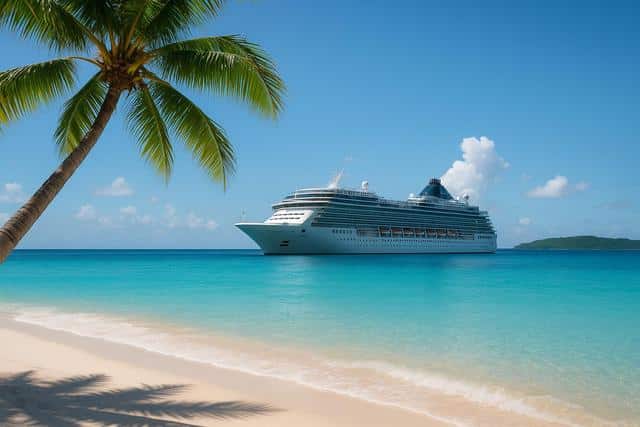
Book now: Caribbean Cruises on a budget
What “budget” really means for Caribbean cruises in 2025
“Budget” doesn’t mean bare-bones—today it means being intentional about the variables that move your total cost. Those variables are the sailing window, the departure port you can reach affordably, the ship and cabin category, and what you buy on board beyond the fare. For many travelers, the sweet spot is a 3–5 night sailing on a mainstream line from a driveable port, with an interior or oceanview cabin and restrained onboard spending. A weeklong cruise can still be cost-conscious if you choose an older ship, shoulder-season dates, and a simple daily routine that favors included dining and activities.
Two realities to keep in mind: advertised fares rarely include taxes, fees, and port expenses, and onboard purchases add up fast. Aim to plan your total trip cost—not just the fare—so you can compare options confidently.
When to sail for value—and why storm season matters
Caribbean pricing tends to dip during shoulder periods like late August to early November and parts of January–February, outside holidays and school breaks. That span overlaps the official Atlantic hurricane season, which runs June 1 to November 30, according to NOAA’s guidance [1] and the National Hurricane Center’s reference page on season dates [2]. NOAA projected an above‑normal 2025 season, a reminder to protect your booking with travel insurance that covers weather disruptions [3].
Practical approach: book shoulder-season sailings for the lower fares, monitor forecasts in the two weeks before departure, and build flexibility into flights and hotels. Mainstream cruise lines have well‑rehearsed protocols for weather reroutes, and itineraries are adjusted as needed to keep guests safe.
Where you depart can lower your total trip cost
Driving to a port often saves more than shaving a few dollars off the fare. Florida’s major homeports have scaled capacity, which helps keep short‑caribbean itineraries frequent and competitively priced. Port Canaveral recently reported a single‑month record of roughly 926,000 passenger movements and expects a record fiscal year [4]. Nearby, Fort Lauderdale’s Port Everglades set a new annual passenger record and is forecasting further growth in FY2025 [5]. For cruisers in Texas and the central U.S., Galveston continues to climb in volume with expanded sailings and infrastructure, making drive‑to trips more feasible [6].
Industry‑wide, the Caribbean remains a leading destination in the latest CLIA outlook, reflecting supply and demand that favor value seekers (more short sailings, more berths, and a wide range of ships) [7]. AAA and industry trackers also expect 2025 to remain busy, which rewards travelers who book smart and early for high‑demand dates [8].
Price snapshot (as of September 2025)
Recent pricing shows how ranges shake out for mainstream, budget‑minded trips. Analysts note many Caribbean sailings still average roughly $150–$200 per person, per day inclusive of fare and typical onboard spending, which compares favorably with land vacations [9]. Earlier broad lookbacks placed short Caribbean base fares (before taxes/fees) near the low‑$300s to $400s per person and weeklong base fares in the mid‑$600s, acknowledging wide variance by ship and date [10].
Live examples around late 2025 demonstrate workable budget windows:
- 3‑night Bahamas/Caribbean samplers on mainstream lines frequently show lead‑in rates between about $400 and $600 per person for interior staterooms, date‑dependent, and can dip below $400 on select shoulder sailings [11][12].
- Balcony rates on short sailings can sometimes undercut interior rates during promos (inventory‑driven), so it pays to check multiple cabin types on the same date [11].
Note on Mexico calls: as of July 2025, Mexico introduced a phased cruise passenger fee starting at $5 per person, scheduled to rise in steps under current agreements—cruise lines typically bundle this with port taxes [13][14]. This is modest on a per‑person basis today but worth noting for family totals.
Bottom line on price: align expectations to the ship and date, then compare the full invoice (fare + taxes/fees) across a few departures before you commit.
Quick comparison: levers that lower your cruise bill
The table below condenses common trade‑offs budget cruisers use to dial in savings.
| Choice | Typical impact on cost | Trade‑off |
|---|---|---|
| 3–5 nights vs. 7 nights | Shorter = lower trip total | Fewer ports, less time to unwind |
| Interior vs. Balcony | Interior often 20–40% less | No private outdoor space |
| Older ship vs. New mega‑ship | Older ships often priced lower | Fewer marquee attractions |
| Shoulder season vs. Peak holidays | Shoulder often 10–30% lower | Higher weather flexibility needed |
| Drive to port vs. Fly | Save on airfare/hotels | Longer road time; parking fees |
Interpretation: combining two or three of these choices (e.g., interior cabin on a 4‑night older ship you can drive to) usually unlocks the strongest value.
Onboard spending you control—so you keep the trip affordable
Gratuities, beverages, specialty dining, Wi‑Fi, and shore excursions are the big variables you can tailor. Mainstream lines auto‑charge daily service amounts; for example, Royal Caribbean’s suggested daily gratuities for standard cabins rose to about $18.50 per person per day (suites higher) in late 2024, and policies may adjust over time [21]. Norwegian lists $20–$25 per person per day depending on cabin category [22]. Beverage packages can be convenient but aren’t required; Carnival publishes package details and per‑day rates so you can compare against your actual consumption [20].
- Value tip: price out Wi‑Fi for only the devices and days you need. Many travelers buy a smaller plan and go offline in port.
- Excursions: mixing one paid highlight with DIY beach time often cuts the port‑day budget in half.
Synthesized expert insight: “The biggest savings happen before you board—locking the right itinerary, cabin, and dates. Once you’re on the ship, decide which two or three extras actually enhance your week and skip the rest.”
Health, safety, and documents—what’s current
The CDC’s Vessel Sanitation Program conducts unannounced inspections and posts scores you can review before booking [15]. You can also search inspection histories by ship [16]. For vaccine‑preventable illnesses, the CDC has updated maritime guidance (e.g., measles) relevant to cruise environments [17].
Documentation: on closed‑loop cruises that begin and end at the same U.S. port, U.S. citizens may re‑enter with government‑issued photo ID plus proof of citizenship under WHTI rules—but individual countries you visit may still require a passport, so check your specific itinerary and cruise line guidance [18][19]. A valid passport is the most reliable document for international travel and simplifies unexpected flight diversions.
How to book a budget‑friendly Caribbean cruise in five clear steps
1) Pick your window and port. Start with two shoulder‑season weeks you could sail and two departure ports you can reach affordably. 2) Shortlist ships and itineraries. Compare a couple of older, well‑reviewed ships and a newer one to gauge price vs. amenities. 3) Price the full invoice, not just the fare. Look at fare plus taxes/fees across three or four dates. 4) Add realistic onboard line items (gratuities, Wi‑Fi, one excursion, and beverages) to your worksheet. 5) Book the itinerary that fits your total trip target—not just the lowest fare.
If you want proof‑of‑price snapshots, use date‑specific pages from neutral‑toned comparison portals or large agencies to sanity‑check ranges (e.g., late‑2025 3‑night samplers around the mid‑$400s per person for interior cabins) [11][12]. Hold or refundable fares can add peace of mind if your dates might shift.
FAQs for budget Caribbean cruises
Budget Caribbean Cruise FAQs
What’s a realistic total daily budget?
As a planning anchor, many mainstream Caribbean trips land around $150–$200 per person per day including fare and average onboard spend, though careful choices can pull this lower [9].
Is hurricane season too risky to book?
It’s a trade‑off: better pricing and availability versus higher weather variability. Buy travel insurance that covers weather, monitor NOAA updates, and build flexibility into flights [1][2].
Do I need a passport for a Caribbean cruise?
For closed‑loop itineraries, U.S. citizens may re‑enter with acceptable WHTI documents, but a passport is strongly recommended because some ports and any unexpected flights will require it [18][19].
How do gratuities and beverage packages affect a budget trip?
Daily service charges and drink packages can meaningfully change totals. Review the line’s current policies and run the math against your habits before buying [21][20][22].
Are short cruises worth it if I’m cost‑focused?
Yes—especially if you drive to port. A 3–5 night sailing can deliver the Caribbean vibe at a lower total outlay. Just remember that per‑day pricing can be comparable to longer trips; savings come from fewer days and lower travel costs.
The bottom line
Caribbean cruises remain among the top options for affordable warm‑weather getaways because you can control the biggest cost levers: date, ship, cabin, departure port, and onboard choices. Book shoulder‑season dates, compare full‑invoice totals across a few sailings, and keep your onboard spending focused on what you’ll truly use. With thoughtful timing—and awareness of current policies on weather, fees, health, and documents—you can capture the sea‑and‑sun experience you want without stretching your budget.
Websources
- NOAA – Atlantic hurricane season overview
- National Hurricane Center – Season dates and resources
- NBC6 – NOAA’s 2025 outlook coverage
- Port Canaveral – Record month release
- Port Everglades – Passenger record announcement
- Houston Chronicle – Galveston growth and rankings
- CLIA – 2025 State of the Cruise Industry
- Reuters – AAA 2025 cruise forecast
- Wall Street Journal – Cruise pricing context
- NerdWallet – Caribbean cruise cost analysis (2024 sample)
- iCruise – 3‑night fare example (Sep 26, 2025)
- Avoya Travel – 3‑night fare example (Oct 24, 2025)
- CruiseMapper – Mexico cruise passenger fee revision
- FCCA – Statement on Mexican cruise tax
- CDC VSP – Cruise sanitation FAQ
- CDC VSP – Ship inspection search tool
- CDC – Measles guidance for cruise operations
- CBP – WHTI FAQs (closed‑loop cruises)
- DHS – WHTI overview
- Carnival – CHEERS! beverage package details
- Royal Caribbean Blog – Gratuity rate update
- Norwegian Cruise Line – Onboard service charge


